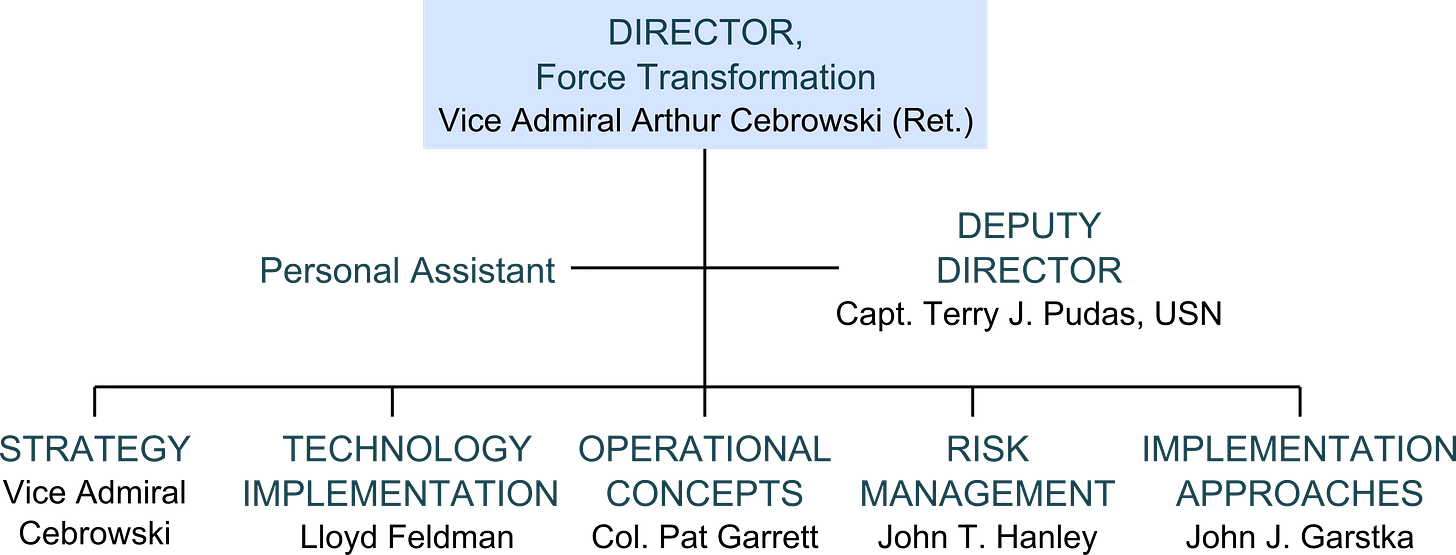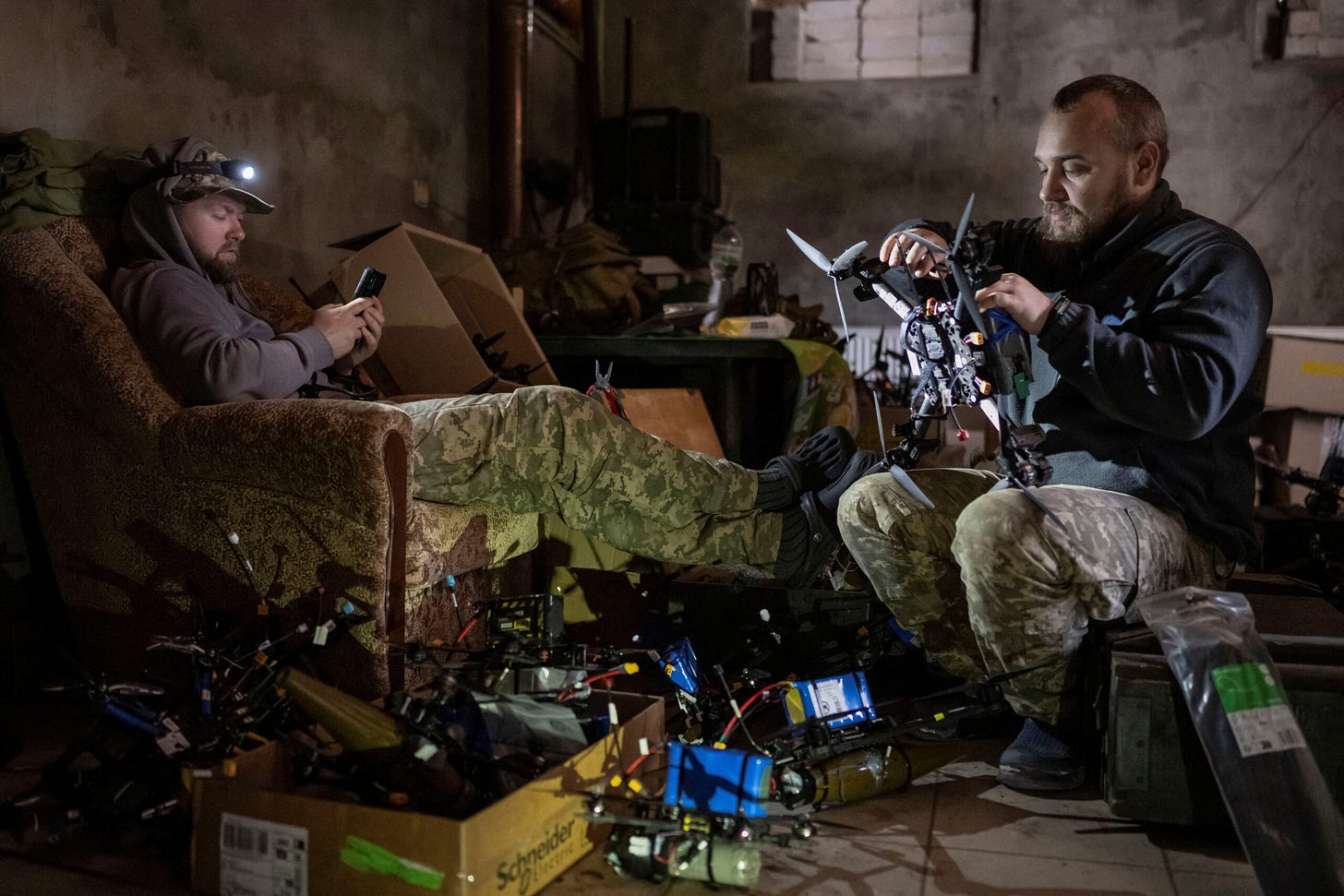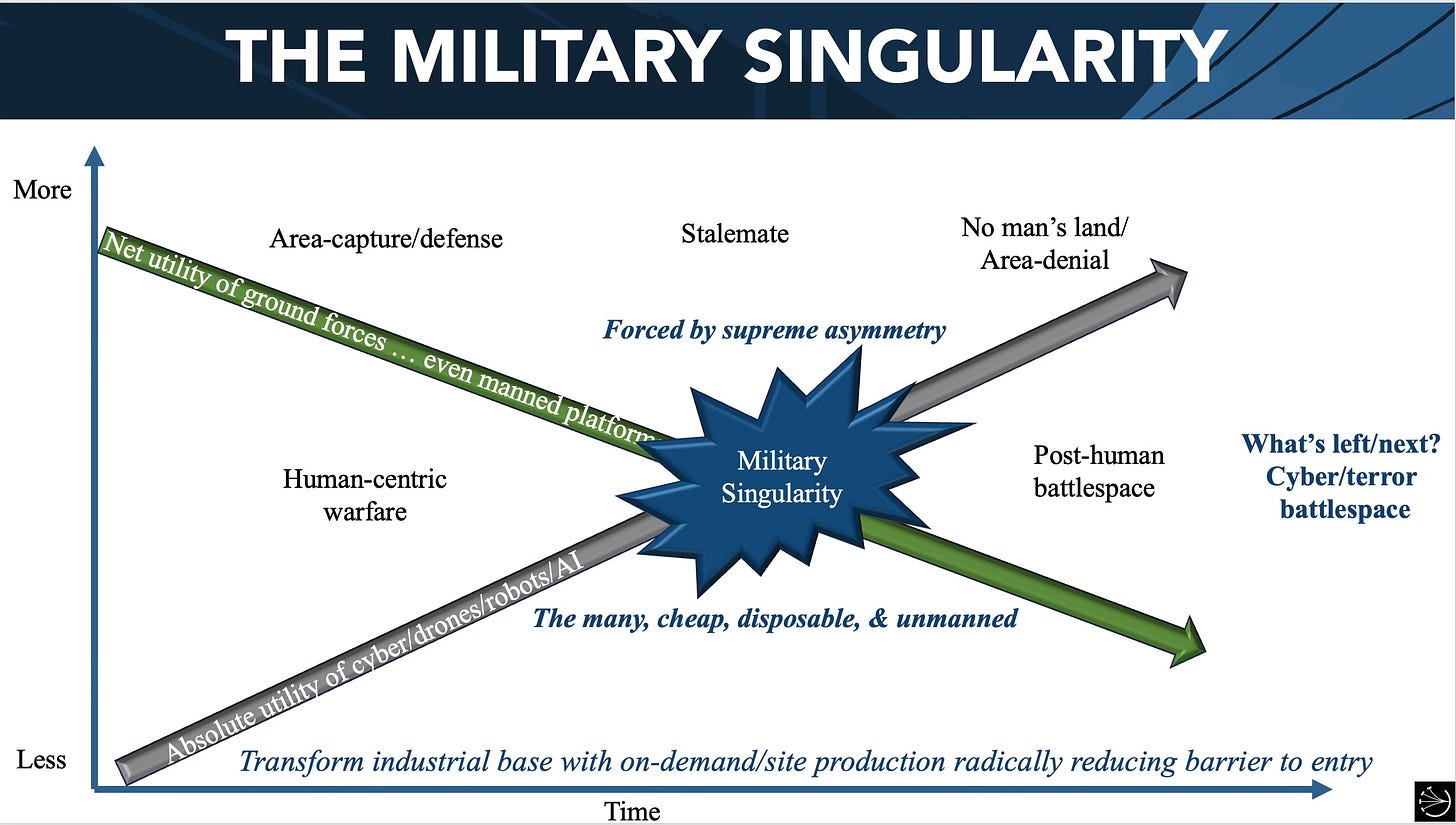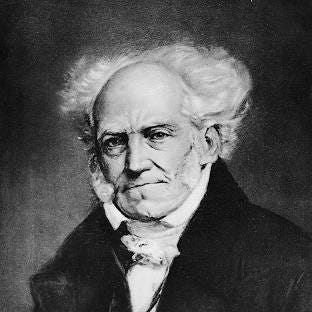
As an alumnus of the George W. Bush administration’s Office of Force Transformation (OFT, 2001-2006, before its dissolution/absorption into the Office of Secretary of Defense more broadly), I have tracked the slow-slow-fast rise of the Defense Innovation Unit (DIU) launched by SECDEF Ash Carter in the waning days of the second Obama administration.
SECDEF Donald Rumsfeld stood-up OFT as a special reporting-to-him unit led by then just-retired Vice Admiral Art Cebrowski, who, right up to 9/11 was president of the Naval War College (where I pretty much worked solely for him on Y2K and the future-of-globalization collaboration with Cantor Fitzgerald at World Trade Center One) and was well-established as the “father of network-centric warfare” (NCW; core concept being that networks define the force of the future and not platforms).
OFT was the policy incubator and NCW “idea hampster” (I was described by Art as his “idea guy” — a wholly undeserved and unbelievable concept if you ever encountered the man, but it was a huge motivator for me in the work) for turning the US Military into a more networkable force capable of taking on the challenges of a globally networked radical insurgency like Al-Qaeda. As such, the Global War on Terror was seen as a preview of coming threat environments in which all manner of “grey warfare” would be applied (of the sort we now see regularly out of Russia and China experiments with).
In my Pentagon’s New Map presentation and book, I argued that the future force would favor the many, the cheap, the disposable, and the unmanned — or basically how Ukraine has stood up against Russia’s military invasion these past now-almost three years. Naturally, this message, and that of OFT in general, was not welcomed by the Military Industrial Complex that was then still wholly optimized to crank out $12B carriers and $100M aircraft. Compared to that vast money-printing machine, we were talking rapid adaptation of private sector technologies along networking lines — very disruptive.
Opposition to Cebrowski and OFT throughout the defense community was fierce. We were accused of dreaming up conflicts that weren’t all that important relative to classic great-power and superpower warfighting scenarios where extremely costly platforms were considered untouchably supreme (the unthinkability of losing a carrier, for example, in combat, which is counter-intuitive when you think about it, because you can lose ANYTHING in combat).
At the end of 2004, Cebrowski suffered a re-occurence of cancer from his young-adult days and OFT’s fate was sealed — as was mine. With Cebrowski out of government, I got tossed by the Naval War College, leaving government service on almost the very day of his second retirement.
I have lived in the world of tech start-ups pretty much ever since, exploring all the same ideas and ambitions but from different angles. That’s continuing for me at Throughline, where I now work primarily with CEO/Founders of high-tech companies, increasingly centered on the advancement of Explainable Artificial Intelligence (XAI).
The DIU is logically considered a next-iteration successor to OFT. Plenty of differences, but the ethos and the ambitions are the same: to transform force structure from its platform-centric past to something far more networked, cheap, disposable, and unmanned. But, most of all, it has to be adaptively field-able at high speed, cranking like those Ukrainian drone demons do on a daily basis
The clearest evidence of this shift has been aided by Ukraine’s embrace of drone warfare: At the start of the Biden administration the Pentagon was still thinking of the pace-setting Taiwan scenario in traditional platform-centric terms. Now, the most audacious thrust is this idea of creating a “drone hellscape” in the opening hours and days of any Chinese invasion.
That is a huge change very quickly capitalized upon (really, that’s bureaucratic warp speed), with DIU as the triggering bureaucratic actor — so much more hands-on in terms of acquisition than OFT ever dreamed of becoming back in the day.
Why?
Because back in the GWOT (Global War on Terror) day, OFT’s swarm-defined operational ethos (kill their conventional force with our vast network of drones) was seen as (1) a high-tech fantasy and (2) a threat to the military’s traditional force structure and acquisition approaches — or what I called the Rise of the Lesser Includeds (all those short-of-strategic war operations that allegedly could be folded into a force structure built primarily for strategic warfare — a wholly untrue notion as history has taught us time and again).
Now, the whole nexus of drones/robots/AI/additive manufacturing … they’re collectively seen as the Big War force’s salvation in countering China’s growing lead in traditional platform numbers (particularly in the Asia theater). That Military Singularity, as I call it, now performs the same solution-role as nuclear weapons did when we were perceived as falling behind the Sovs (“bomber gap” —> “missile gap,” —> “warhead gap” —> “survivable second-strike gap”).
The Military Singularity now in the works is thus the equalizer or the leap-ahead (often referred to as an “offset strategy”) to the next war fighting paradigm.
DEFENSE NEWS: The Pentagon’s ‘Replicator’ drone bonanza faces an uncertain future
Enter the formidable Kathleen Hicks as 35th United States Deputy Secretary of Defense in 2021 with the inbound Biden Administration.
In many ways, Hicks is the implementing successor to Cebrowski’s blue-sky operation in OFT: he dreamt and experimented and she is accomplishing and codifying.
Both Hicks and Cebrowski advocated for leveraging networks — whether human or technological — to improve military effectiveness. Hicks articulated a vision that aligns with Cebrowski's legacy by promoting collaboration and innovation within the DoD and between DoD and the high-tech sector (a serious fulfillment of Art’s vision).
Hicks is now best known for her Replicator program (yes, she is a Trekkie also) that is designed to revolutionize US military force structure through the rapid-fire, almost on-demand fabrication and employment of drones and robots and AI to generate that “drone hellscape” the Pentagon now promotes as the ANSWER to China’s growing military threat.
The big question now? Will the Replicator program outlast her tenure?
In a speech last August, Kathleen Hicks listed the two most common questions about Replicator, her two-year pledge to buy thousands of drones and help the U.S. military compete with China.
“When we launched Replicator, a common refrain I heard was: ‘Can it work?’ These days I’m more likely to hear: ‘Will it stick?’” said Hicks, the deputy secretary of defense.
The “work” part is clear: the Military Singularity that I describe and Hicks is building represents the future of US military power, which, per larger trends, becomes more security focused than defense focused, meaning less about concentrating solely on Big War and more about covering all that Grey War/Hybrid stuff that we see happening around the world more and more.
Why this matters: Defense is zero-sum and no great help to globalization’s continued advance and maturation — much less digitalization. Security is non-zero-sum, as in, you can have more and I can have more and we’re both that much better off because of it.
Defense is the past and security is the future, essentially obliterating the line between imagined “away game” and “home game” conflict dynamics and, scarily enough, blurring the divide between military and police (Orwellian paradigms of omniveillance).
In short, a much more systems-level approach to national security, which, as I argued in The Pentagon’s New Map, would lead to a new type of military more optimized and dedicated to covering that wider panoply of operations short of strategic warfare — my SysAdmin force that, as I liked to say, would be more interagency than just DOD, more civilian than uniform, more security focused/engaged than just defense/deterrence-centric, and more private sector than public sector (thus a huge rise in DoD-private high-tech-sector collaboration).
[NOTE: The closest any power has come to SysAdmin force concept to-date is China with its Belt and Road Initiative, following my dictum that any intervention overseas HAS to leave the country in question more connected to the global economy than prior.]
This is what former Google boss Eric Schmidt has long been arguing for. His vision for the U.S. military aligns closely with Cebrowski’s foundational NCW concepts and resonates with Hicks’ strategic outlook, an alignment emphasizing a transformative approach to military operations through advanced technology and connectivity.
Schmidt on the quasi-outside and Hicks on the inside have been a powerful combined influence. They have collaborated closely on initiatives aimed at enhancing U.S. military capabilities, particularly through the integration of advanced technologies like AI and drones.
Example of the Drone Development Initiative, where Schmidt is leading a secretive project focused on developing advanced military drones to counter China's growing capabilities. This initiative aligns with Hicks' emphasis on addressing the technological gap between the US and China. Prior to that, Schmidt chaired the Defense Innovation Board (DIB, under Trump 1.0, mind you), where he advocated for increased collaboration between the tech industry and DoD. His leadership in this role facilitated discussions about leveraging commercial technology for military applications, a vision shared by Hicks later, under Biden, as she pushed for modernization within the DoD.
In sum, both Hicks and Schmidt have emphasized the importance of AI in transforming military operations, and to me, that is OFT finally becoming real.
Am I surprised by the two-decade lag? No. That’s pretty much par for the bureaucratic course. I just wish Art had lived to see all this and to have participated further in these evolutions.
As for me, I learned long ago that, if I’m doing my job right, my vision is about two decades into the future, meaning I am a nutcase in the present tense and a pathetic purveyor of conventional wisdom when that future tense arrives.
Per Arthur Schopenhauer (a quote I have often flashed at the end of briefs):
All truth passes through three stages. First, it is ridiculed. Second, it is violently opposed. Third, it is accepted as being self-evident.
So, if you’re doing this stuff correctly, you mostly get razzed as a bullshitter, then considered a dangerous threat, and then laughed off as yesterday’s news.
Really makes you want to be a strategic thinker, doesn’t it?
As I have often told students who ask: if anticipation isn’t your favorite emotional state, then don’t go into this business because it will wear you the f#@k out on a day-to-day basis in which you will be constantly confronted with two feedback loops: one that says you’re a true genius and visionary and another that says you are the biggest dumbass in the business!
In short, you’re either 5 stars or no stars.
But, back to the question of the DEFENSE NEWS piece: what happens to the Hicks-Schmidt vision and push under Trump 2.0?
Since [Hicks] first unveiled Replicator a year and a half ago, it’s nearly become a trademark. Hicks has sat in all of the Pentagon’s major meetings on it. She’s read every story published about the program, prepared in files from her staff. And she’s called its success a referendum on her leadership.
Senior Pentagon officials interviewed for this story said the program is on schedule largely through her effort. Now, as Hicks leaves office, the question is whether it can survive without her.
Cebrowski’s influence was short-circuited by cancer, whereas Andy Marshall’s (in the still-there Office of Net Assessment) was long-lived due to his ability to survive administration transitions.
So, what can we expect here?
Schmidt is a world-class Tech Bro, in the best sense of that often derogatory term. The fact that the Tech Bros seem ascendant within the Trump administration, as much it drives Steve Bannon nuts (a good sign), indicates great possibilities for further evolution going forward.
Here, for example, Elon Musk is a positive influence in my estimation (he also drive me nuts on several fronts), seeing a future US military defined by drones instead of vastly expensive and vulnerable fighter/attack aircraft. That remains a supremely disruptive message, but the truth.
So, early indications are good:
Republicans and Democrats have applauded the idea behind Replicator. To compete with China, they argue, the Pentagon needs cutting-edge weapons much faster. Hence, aides in Congress and executives at drone firms said they expect it to endure — albeit with changes.
And after 16 months, many officials working on the program outside the Pentagon say the biggest change it needs is size. Hicks made the bet to start Replicator, no small feat in a risk-averse bureaucracy, they acknowledged. But without more funding and more weapons on order, it won’t reach its true promise: a military nimble enough for the future of war.
Keep reading with a 7-day free trial
Subscribe to Thomas P.M. Barnett’s Global Throughlines to keep reading this post and get 7 days of free access to the full post archives.











